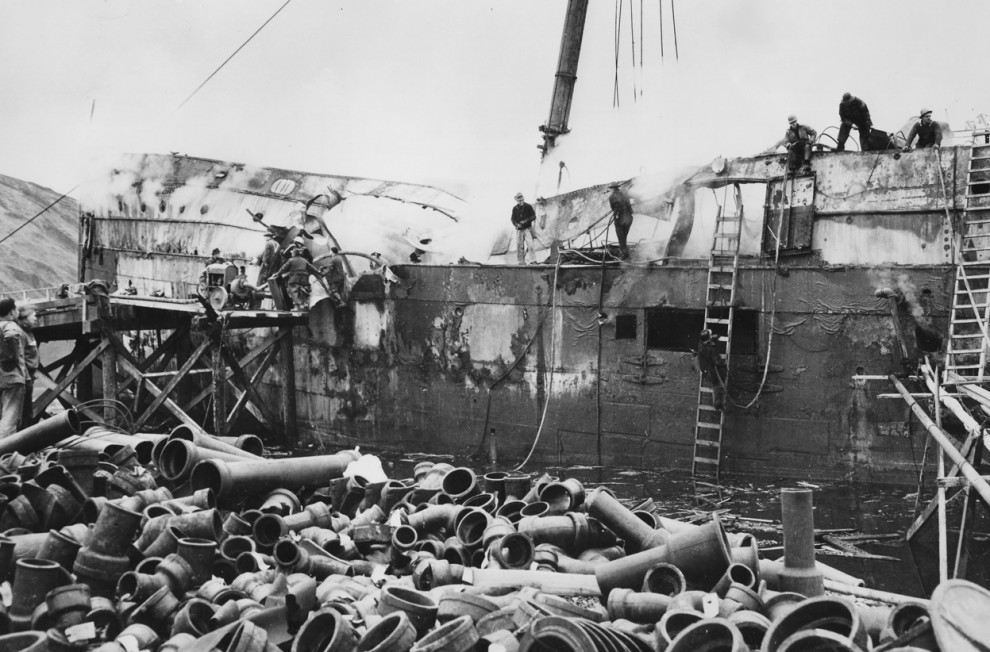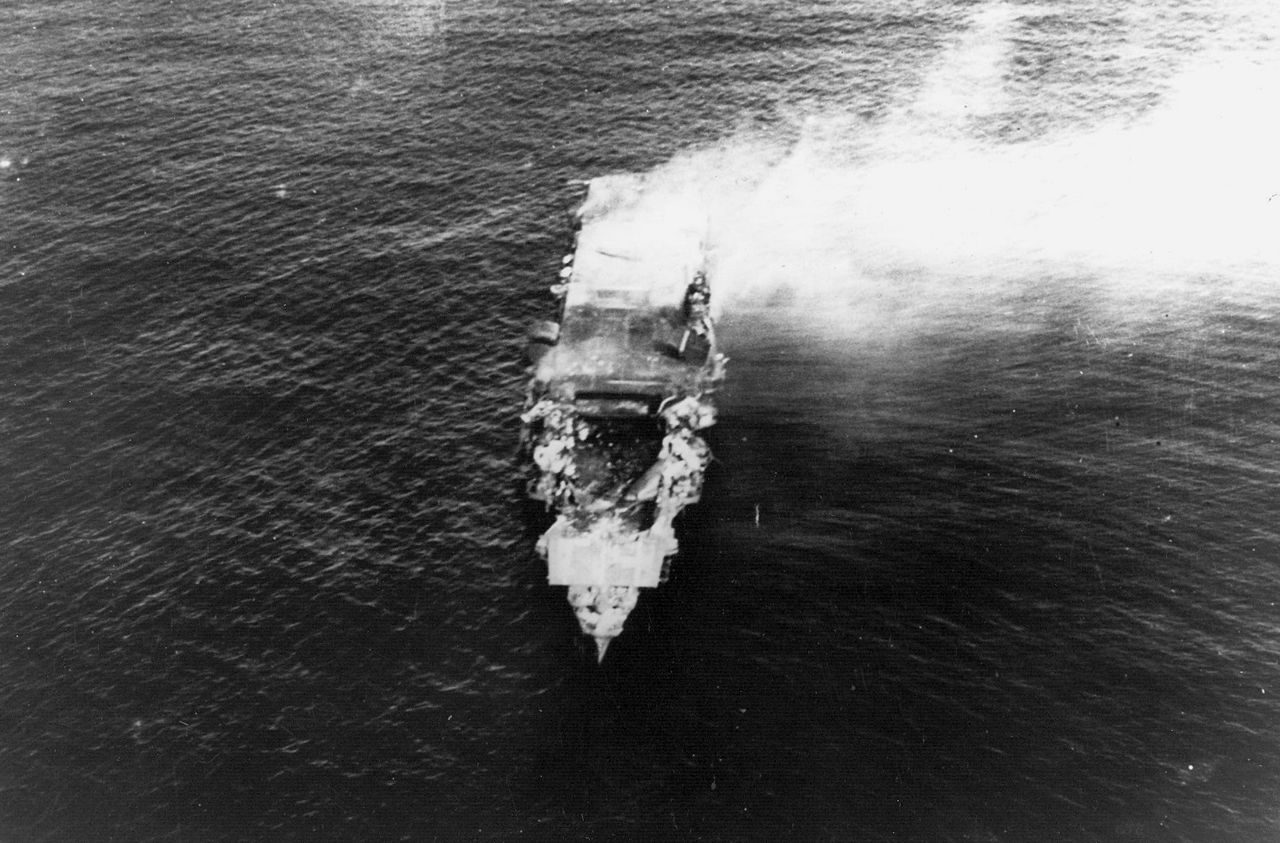Air Operations, Europe
BOMBER COMMAND- 24 Bostons are sent to bomb the power stations at Le Havre and Ostend and the Morlaix airfield. All targets are bombed with no losses.
- Essen is the target as 180 aircraft including 98 Wellingtons, 33 Halifaxes, 25 Stirlings, 13 Lancasters and 11 Hampdens are sent. This raid is another failure as the bombs are scattered over a large area. Essen suffers minor property damage with 10 people being killed and 68 are injured. 12 aircraft are lost. In the total are 8 Wellingtons, 2 Stirlings, 1 Halifax and 1 Lancaster.
- In minor operations, 15 planes lay mines in the Frisians and Queberon Bay and 3 make leaflet flights over France. There are no losses.
Dutch Harbor, Alaska Damage |
 |
Air Operations, New Guinea
Bismarcks-based 5th Air Force B-17s attack the Rabaul dock area.
[Aleutian Islands
Japanese forces occupy Attu Island in the Aleutians. Dutch Harbor is attacked by Japanese carrier aircraft.
[Battle of Midway
Midway ranks on one of the most decisive victories of the war. With the lost Japanese carriers and 332 planes have gone many irreplaceable pilots. The American air losses are 147 planes. The only large carriers the Japanese have left are Shokaku and Zuikaku which are still refitting after the Coral Sea Battle. The American success is perhaps the clearest example of the whole war of a victory based on superior intelligence. The urgency with which the carriers were rushed from the Coral Sea and repaired and replenished at Pearl Harbor was based entirely on the code-breaking information. The Japanese, by contrast, produced an over-elaborate plan with their forces wastefully dispersed. Their 4 'light' carriers, for example, could carry up to 140 aircraft and the survivors from the air groups of Shokaku and Zuikaku could have brought the main force up to full strength - there was room for 50 more planes. The Japanese scouting was marred by ill-luck and poor reporting, and the timing of the American attacks in the morning was most fortunate, especially when they had not been well organized.
Japanese Carrier Hiruy |
 |
After Midway the American strategic position and the strength and quality of their forces can only improve. The Japanese have lost the initiative.
[Battle of the Atlantic
The US freighter Delfina (3480t) is torpedoed and sunk by U-172 with the loss of 4 crewmen. 12 survivors are rescued by the submarine chaser PC-67 and 15 more reach Montecristi, Dominican Republic in a lifeboat.
[Caribbean
The US tanker L. J. Drake (6693t) is sunk by U-68 north of Aruba, N.W.I. with the loss of all 41 on board.
[Diplomatic Relations
The United States declares war on Bulgaria, Hungary and Rumania. In calling for the actions, Roosevelt says they declared war first, but 'I realize that the three Governments took this action not upon their own initiative or in response to the wishes of their own people but at the instruments of Hitler.'
[Eastern Front
German forces smash Russian's outer defenses at Sevastopol.
[India
A huge British convoy of men and material reaches India intact, substantially raising India's defensive capability against the Japanese.
[Indian Ocean
Japanese submarines are active in the Mozambique Channel.
[North Africa
The British, having lost the best opportunity, mount attacks on 'The Cauldron', codenamed ABERDEEN. One armored brigade, 32nd Army Tank Brigade, blunders into a minefield and loses 60 out its 70 tanks and another, the 22nd Armored Brigade, loses touch with the infantry and artillery which it should be supporting. There is a lack of coordination between the British units and over the next few days all these units are defeated in detail. Rommel launches a counterattack in the afternoon sending his reserve tanks eastwards.
By sunset every British unit trying to get into 'The Cauldron' has been driven back. Casualties to the 8th Army mount to 6,000 dead, wounded and missing. Rommel announces that he has taken 4,000 prinsoners and has captured 150 British tanks. The tank forces available to the two armies are now about equal in numbers, but in quality the Germans are far ahead.[MORE]
[Occupied Soviet Union
The Germans launch Operation BIRDSONG between Roslavl and Bryansk with 5,000 troops. Their target is 2,500 partisans that are operating in the area. Over the next 4 weeks 1,198 partisans will be killed for the loss of 58 dead. But the partisan attacks continue. One German officer states: 'The partisans continued their old tactic of evading, withdrawing into the forests, or moving in larger groups into the areas south and southwest of the Roslavl-Bryansk highway and into the Kletnya area.'
[United States, Home Front
An explosion at an ordnance plant in Elmwood, Illinois kills 49 civilian war workers.
[United States, Policy
Roosevelt says 'authoritative' reports indicate the Japanese are using poison gases in Chiina. He condemns the use of 'poisonous and noxious gases' by Japanese forces in China and warns Japan that if such actions continue, the US will retaliate 'in kind'.
[